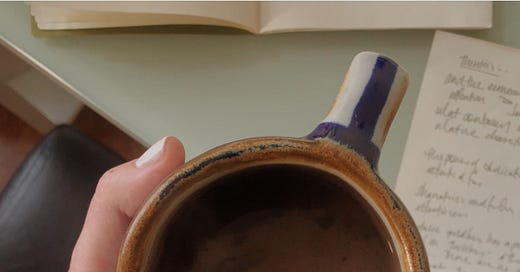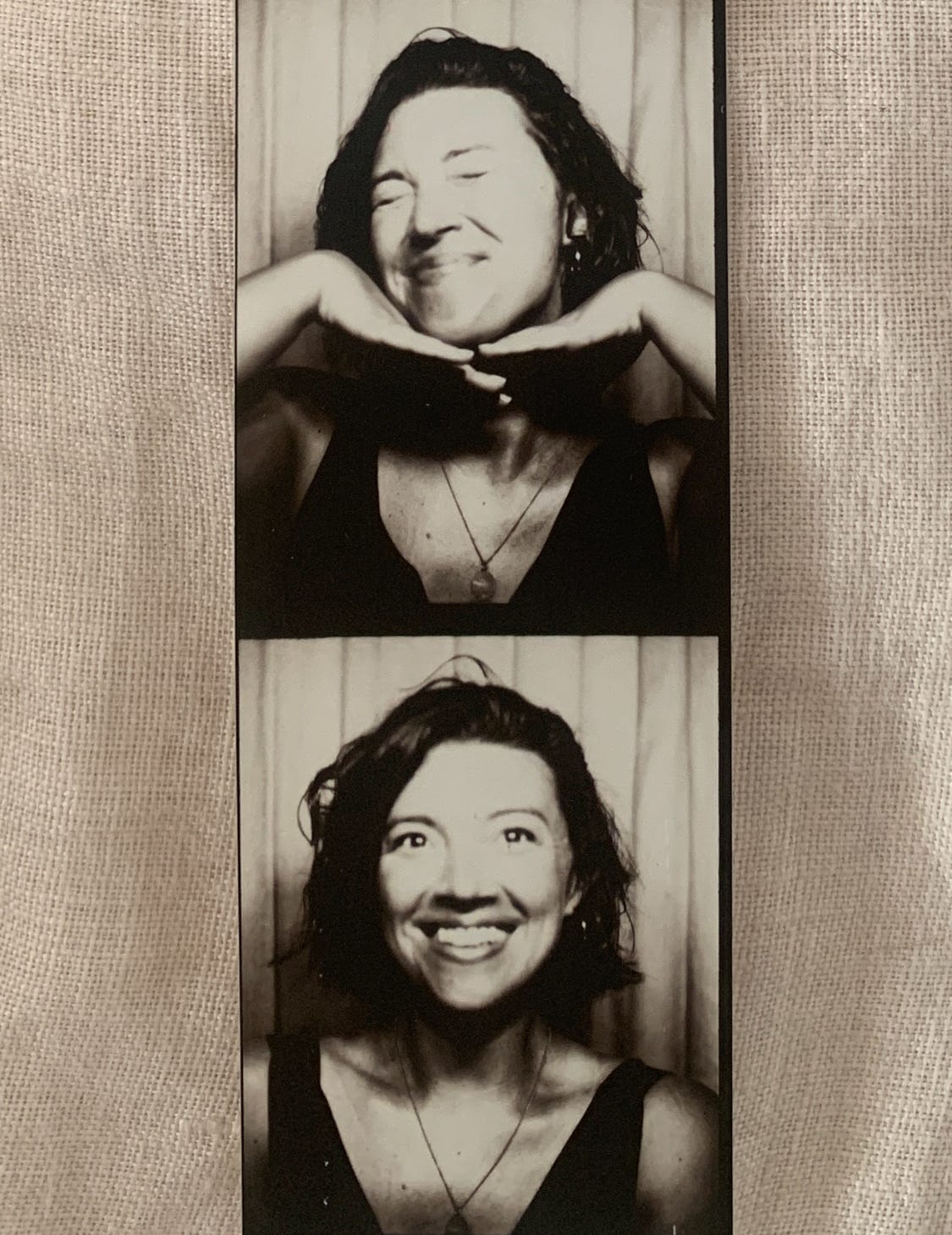Next week and the week after, find the corner of your creative practice. If you’ve been seeking some creativity or grounding the tactile or the texture and nature of paper, sign up. This week and next week’s workshops in Brooklyn center in on bookmaking; February experiences arrive next week. If you’re curious about starting, strengthening, or sustaining a creative, writing, or meditation practice, my 1:1 sessions may be a good fit. As always, shop journals at Odette Press.
“May everyone be happy.
May everyone be free of disease.
May auspiciousness be seen everywhere.
May suffering belong to no one.
Peace.”
- David Lynch
From the rim of the ceramic cup rises up a curl of steam. Inside is cardamom, rose, dark chocolate; I hold it in two hands. A damn fine cup of chocolate. The cold front of winter moves through, arching a freeze across the city, bridging the flat white distance across the horizon, an environment where coils of breath can be seen in dimension — present and spiraling. Everything in a slowing motion. Hands, cold, wrapped around cups and mugs, bowls, paper and ceramic, in evenings and mornings, are kept and held even if only for a moment and then discarded. Anything to be warmed in the process.
In the morning, the air is a single digit. Winter precipitates; snow comes and covers the ground, a veneer of ice and white on the path where I run in the morning. Step, walk, run, slow and fast, and watch for ice, and do so tenderly. I am determined for movement and fresh air to clear my thoughts for the day; I run three miles. To warm, to hold, to tend, to meet the moment: I sit and breathe, stopping to catch my breath, bringing cupped palms to cold cheeks. An exhale seen lingering in the space in front of me. My thoughts are a single digit, too; they move as if frozen. Steam rises, breath leaves. A measure of capacity.
I come home to a rush of heat pushing the key into the lock and opening the door to my apartment. The door swings and whines before slamming and closing, before the vortex of air, a wall of dry city radiator heat rushes in — a contrast. I take off my shoes, turn on the water to boil and reach into the pantry, grabbing mug, glass, grounds for coffee. Reaching into morning, I grab for notebook, pile of books, half asleep pages. I reach into the afternoon for more writing and emailing. I slow, I tune, I sip, I savor. I cup hands around the moment, reaching into night, grounding down into slow rhythms and warming.
I come back to the line of thoughts running through my mind standing in the kitchen. Stand, wait, sip, stretch, I grab for mugs, and cup hands, reaching arms up and toward the ceiling as if mountain — as if pine — while torso holds the body together, as if parenthesis. I sit, breathe, and move. I look toward the city, ask for answers across the skyline, in the ice covered ground below, then hearing none, remember to listen to the space of silence in the basin within me; I close my eyes. Drop down from thought of mind into body into page, cupping and pouring into ideas, a dialogue between basin of body, heart of practice, a line from mind, a channel onto page.
To find the idea, I ebb between stillness and moving. Remnants of memories remain over the cold of miles, onto cold city sidewalks, warmed into motion with breathing. Grounding down, I breathe, I move in circles; I whisper, I bellow. I circle hips, and line, and shape, noticing the structures of thought, sensation, and body that are expressed, or not, and contained. I slow, I tune, I sip, I savor. I pour hot water into mug, mind into body. Idea starts, and I gather my attention together to cup this ephemeral breath into existence. I breath in deeply into belly, cavern of ribs and horizon of chest. Body, housing ideas like canyon, like lake, or basin.
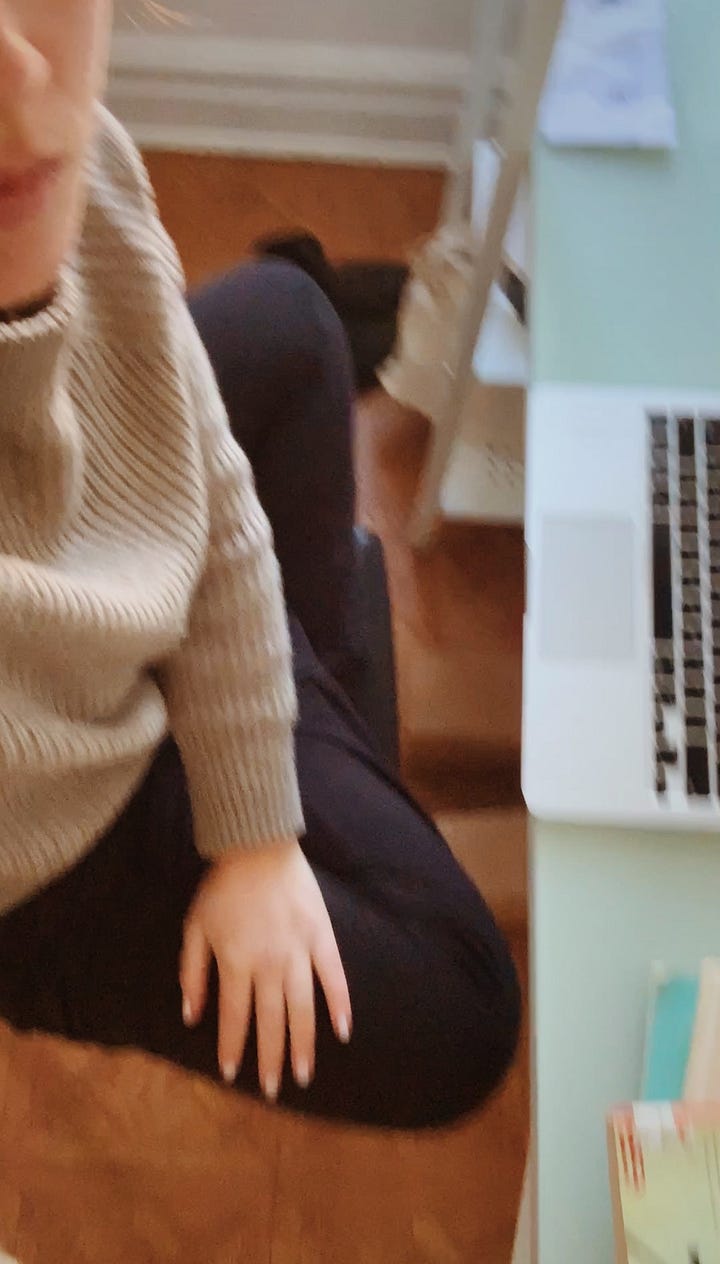
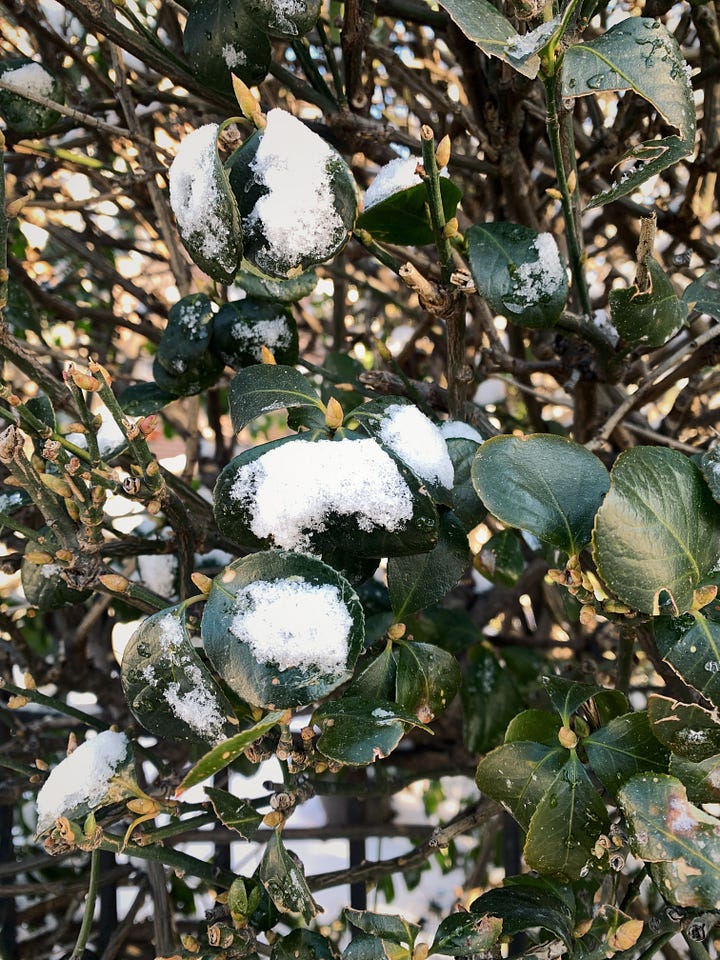
To create a practice is to at once become formless and contained. To tune in to moment, to drop down, and watch, as thoughts flood, rush, freeze, or trickle. Gom — the Tibetan word for meditation — is the process of becoming close with; you open wide into unknowing, you trust your basic goodness, noticing all sensations, then refocus. This practice is strengthening. You strengthen your attention. You become familiar. “Meditation is a dive all the way within, beyond thought, to the source of thought and pure consciousness,” David Lynch writes. “It enlarges the container every time you transcend. When you come out, you come out refreshed, filled with energy and enthusiasm for life.”
My practice starts equally in stillness and movements: the moments of greeting air, slow and freezing, or the contrast of a warm cup held in the morning. To parent, to witness, to hold, to overflow, to befriend, to build capacity. My mother visits me in the city over the weekend; we sit and walk, and talk, and drink coffee, and I think about the economy of attention, the way hands cup around water, each other, intentions, or ideas; how ideas spiral up and coalesce from the depths within us; how the smallest acts of care, repeated, shape the walls, the containers, create the warmth in an experience. How focus is grown, tended to by releasing and revisiting. Filling the glass, filling the cup, turning on the stove, pouring the tea, the coffee, the soup, pouring attention into breathing, wrapping hands around cups, cupping your hands around ideas, you are noticing and replacing. You are being, and becoming familiar.
To parent; to sibling; to partner; to cousin; to friend is to love is to practice. In the morning, my father sends an image of Odette to celebrate her birthday. The image is from the forties or so, and if she were still alive today, she would be 94. Toned in time and sepia, the image is a halo of memory and soft focus; she stares steady, gaze and eyes sharp toward the camera. My paternal grandmother, Aquarius — water bearer. Underneath the image, a line of text: “Friends, always!” Friendship becomes a line, a thread, a river, a tendril, a mug we hold, the place we warm and cool, the cup we hold, the repeated practice, the care we pour into.
To tend is to befriend is to become familiar is to embody moment and memory, to become mirror — to witness flaws, gifts and all, to give warmth, to bear water, to be cool with one’s wisdom and neurosis. To hold yourself in the moment and practice is to cup your attention around your own life tenderly, and to become friend to yourself, each other, and life in the process. Steam rises, breath continues. It is the dynamic force, the creative expression, in a state of being. Are you pouring into yourself? Are you breathing and feeling? Are you here now? Listen, Mary Oliver writes. Are you breathing just a little, and calling it a life?1
On Monday by lunchtime the cold comes; ideas digest. A line of thought is bound together, cupped, held, cornered, broken down, parsed apart, rested, given space, loved, acidified. I rest, I effort, I hold, I sit with. I watch and breathe. I try to stomach, you might say, but I try, and I refuse to stomach what I see: circus, theatrics, artifice, plastic — particles never meant to be digested. “My experience is what I agree to attend to,” writes Jenny O’Dell in How to Do Nothing. I’m reminded why one writes, breathes, or practices, in the first place, which is to cup and hold, or give steadiness and shape the to attentional container, and then from there, pour out. “Only those items which I notice shape my mind,” O’Dell continues. “Without selective interest, experience is an utter chaos.” She writes that “To do nothing is to hold yourself still so that you can perceive what is actually there.” I sit in stillness. I make soup, watch the vegetables simmer down. I ask the essay inside of me, whatever attempt it is I’ll make, to reveal, to bubble, to simmer. I place and replace attention. I remember Jenny Holzer:
“It is in your self-interest to find a way to be very tender”
A cup is a unit of capacity. A measure, a space of holding. Something spacious, strong, to hold and carry. You measure cups of flour, cups of time, weight of attention, grounds of coffee. Histories of cups, of glass, of clay, of wood, of body, of of metal, of boat, of idea. Cups and bodies give us variations on containing. Your body contains you — bowl of the pelvis, the basin of the hips, the well of your attention, and the strength of your core. Holding mind, holding body, holding memory, you meditate, cupping attention, sipping, and savoring.
To place the mind is to hold your inward gaze intentionally while dropping attention into quite focus into moment, and into idea, and expands you beyond your physicality. To breathe and be with is to learn to bear the water of your ideas; to learn to meet yourself again, and befriend, to become familiar — and find ways, repeatedly, to be tender. The practice of steadying attention in mind, body, breath creates “an open receptivity to whatever happens” says Pema Chodron.
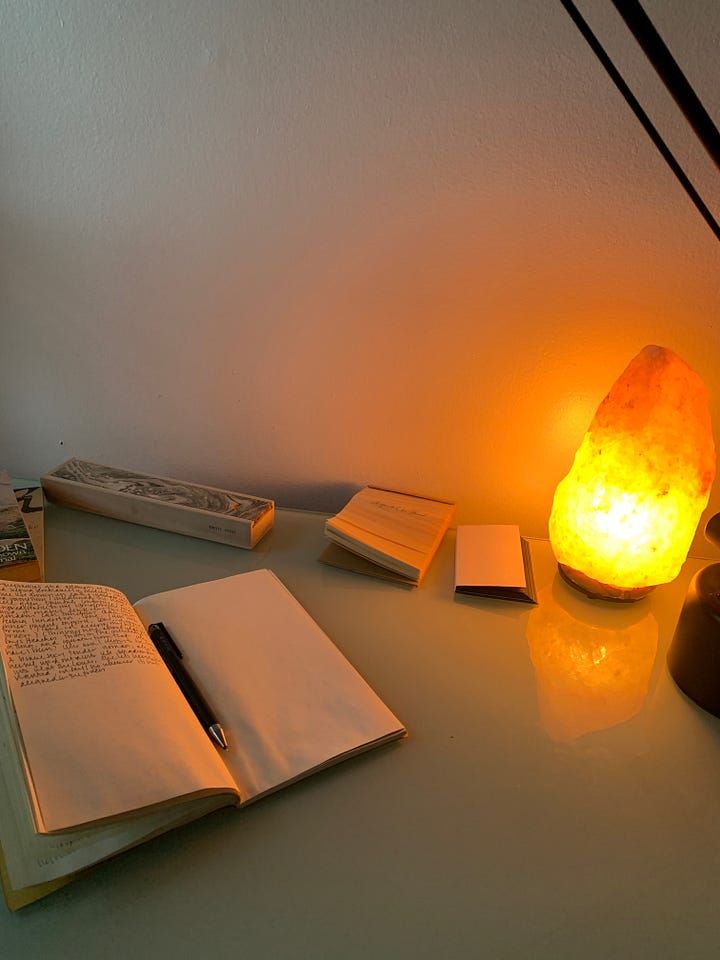
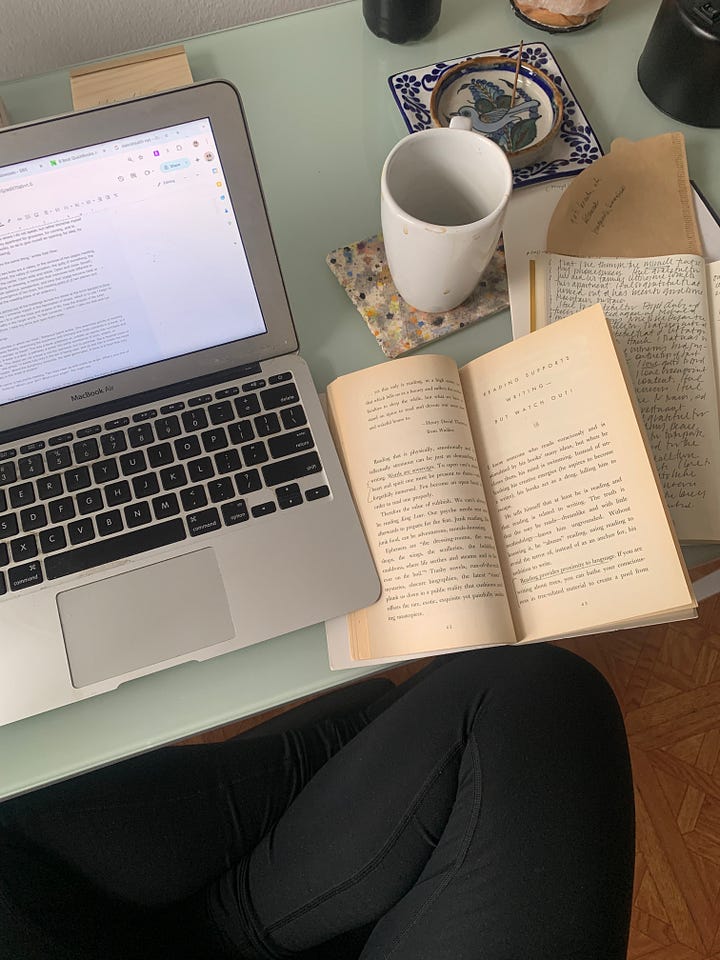
I sit, I breathe, I stand at the basin of the sink and wash my face. It’s night, and I cup hands, I wind down, I wonder. I hold attention around the anatomy of thought, holding onto the temporary gift of idea and water, standing and brush my teeth at the sink. I meditate on what we shape our lives into: what takes root, what gets poured, what gets shared, what gets moved around, and how breath is the vessel strengthen and sustains the container of our attention. All the while, moving through the mundane, the idea continues. The more I write and sit and breathe, the more I learn to embody and become my own friend, teacher, lover, partner, parent, guide. Gom, becoming familiar. To meditate. To sit across from yourself, mug in hand, and hear, feel, and listen. Rise, rinse, repeat.
Natalie Goldberg has a practice2, a prompt I give to myself, and one I teach to my students: you write I’m thinking and then reflect, and notice what you have to say, then repeat I’m thinking again. You think, you write, you repeat. You think, you write, you repeat. You get to know what the contents of your body, heart, psyche, and what it is you have to say. You learn to hold, cup, pour in and out. You sustain and contain. To meditate is to tend to yourself: to befriend mind, body, to build the strength of mind and attention, to hold cup, to warm, to hold tenderly, and build capacity.
What are the simple things that build up the ways and the strength of our lives and practices? The almost imperceptible but intricately tangible. Fold the blanket, make the list, wash the dishes in the sink. Fill the cup. Drink the water. Take the breath. Fill up, empty. To embody an idea is to care for practice is to find a way to nourish and contain.
Draw time like water, and pour attention in, starting a breath at the base of you — the basin. Fill up mind with sensation of your breath filling up your body. Breathe in to the bottom of your lungs, your belly, your mid ribs, then the horizon of your chest. Imagine your body as vast canyon. Then, slowly, exhale. Imagine thought or idea is water, poured from above, cool and clear. Dropping down from the channel of your heart, continue pouring: feel your torso, the strong sides of you, as shorelines or parenthesis, or sliver-of-moon-hands holding yourself up, as the water of idea drops down. Become focused, become wide, become vast, and reach down deep, as if breath in body becomes held in you like vast lake, or still; like waterway becoming ocean. All of the cells of your experiences and ancestors, conspiring to become this, a wilderness.
Take your two palms, and seam them together along your hand’s edge. There — you’ve made a cup, made a bowl, made a practice, something to turn toward, and feel, and tend. In that bowl, pour intention, pour insight, pour ideas, pour warmth and coolness, gathering them up in the process. Come to these shorelines, your creativity, and repeat, often.


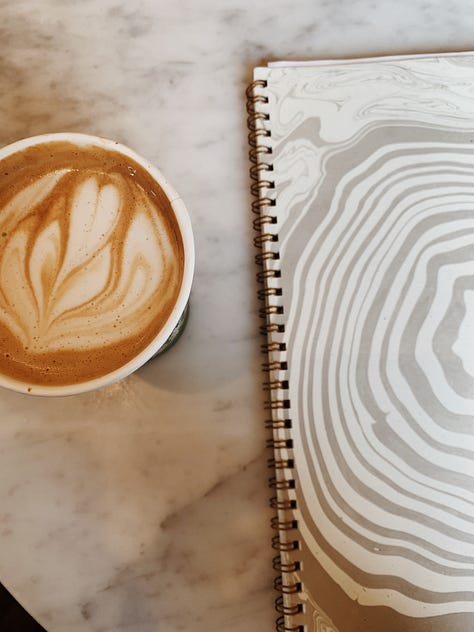
Nourished by, Nourishing:
Reading The Wisdom of No Escape by Pema Chodron, and her talks “All in the Same Boat” and “Loving Oneself and Others”. I’m thinking of the work on intimacy, spirituality, ritual, and holding by dear friend
— “Retrieving the spirit of intimacy” and “Revisiting ‘Patience and Praxis’” over at . I’m running, discovering cold, breath, and making soup. I’m befriending nineteen degrees, running, and making soup. Sitting in silence, watching Blue Velvet.Books purchased through the links above are part of an affiliate program. You support small bookstores, add to your libraries, and I receive a portion of commissions in the process. Thank you for your continued support of this work!
Let’s Practice:
From “Have You Ever Tried to Enter the Long Black Branches?” from Poems, and Prose Poems by Mary Oliver. Jenny Holzer’s text is from Survival, 1983 - 1985

